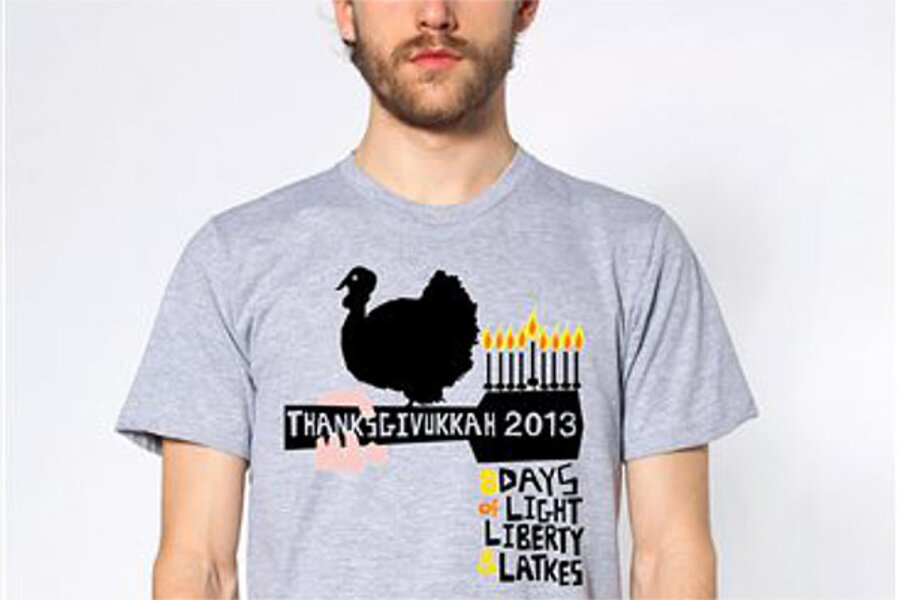Thanksgivukkah? Gobble tov! American Jews prepare for 'Thanksgivukkah.'
Loading...
| NEW YORK
It's a turkey. It's a menorah. It's Thanksgivukkah!
An extremely rare convergence this year of Thanksgiving and the start of Hanukkah has created a frenzy of Talmudic proportions.
There's the number crunching: The last time it happened was 1888, or at least the last time since Thanksgiving was declared a federal holiday by President Lincoln, and the next time may have Jews lighting their candles from spaceships 79,043 years from now, by one calculation.
There's the commerce: A 9-year-old New York boy invented the "Menurkey" and raised more than $48,000 on Kickstarter for his already trademarked, Turkey-shaped menorah. Woodstock-inspired T-shirts have a turkey perched on the neck of a guitar and implore "8 Days of Light, Liberty & Latkes." The creators nabbed the trademark to "Thanksgivukkah."
Songs have popped up with lyrics like these from "The Ballad of Thanksgivukkah": "Imagine Judah Maccabee, sitting down to roast turkey and passing the potatoes to Squanto ..." Rabbi David Paskin, the song's co-writer and co-head of the Kehillah Schechter Academy in Norwood, Mass., proudly declares his the Jewish day school nearest Plymouth Rock.
Let's not forget the food mash-ups commemorating the staying power of the Pilgrims and the fighting prowess of the Jews, along with the miracle of one night's oil lasting eight days. Pumpkin latkes, apple-cranberry sauce and deep-fried turkey, anyone?
"It's pretty amazing to me that in this country we can have rich secular and rich religious celebrations and that those of us who live in both worlds can find moments when they meet and can really celebrate that convergence. There are a lot of places in the world where we would not be able to do that," Paskin said.
The lunisolar nature of the Jewish calendar makes Hanukkah and other religious observances appear to drift slightly from year to year when compared to the U.S., or Gregorian, calendar. But much of the intrigue over Hanukkah this year is buried deep in the history of Thanksgiving itself, which hasn't always been fixed in the same spot. That caused some initial confusion over Thanksgivukkah, aka Turkukkah.
In 1863, Lincoln declared Thanksgiving as the last Thursday in November (the month sometimes has five of those) and the holiday remained there until President Franklin D. Roosevelt signed a joint resolution of Congress fixing it as the fourth Thursday, starting in 1942.
Jewish practice calls for the first candle of eight-day Hanukkah to be lit the night before Thanksgiving Day this year, so technically Thanksgivukkah falls on the "second candle" night.
And then there's Texas. Before 1863, each state decided on its own date for Thanksgiving. As late as 1956, Texans were still chowing down on turkey and stuffing a week later than everyone else, according to a history put together by Chabad.org of the Chabad-Lubavitch movement of Hasidic Jews. That means Jews in that state might have also been lighting their first Hanukkah candle in 1945 and 1956.
There's more early Thanksgiving lore and 2,000 years of calendar tinkering involving the Jewish calendar, but we'll spare you.
Jonathan Mizrahi, a quantum physicist at Sandia National Laboratories in Albuquerque, N.M., puzzled on the convergence last January, in a blog post with buzzed-about line graphs picked up by others online. More than 100,000 people have visited the blog since then, he said, including some who questioned his calculations and prompted him to post a couple of clarifications.
He hadn't made it clear that he was referring to the "second candle" night of Hanukkah, and he hadn't realized Thanksgiving had shifted from the last to the fourth Thursday of November.
The interest, Mizrahi said, "has truly blown me away. I've just been totally flabbergasted at the number of responses."
While the whole thing is lots of fun, is there anything truly cosmic happening here?
Well, there's Comet ISON, which is scheduled to pass close by the sun on Thanksgiving this year and may provide a nice show — possibly even during daylight. Or not, since comets can't always be counted on.
Mom-of-two Dana Gitell, who lives outside Boston, partnered with an artist and the Jewish gift site Moderntribe to create and sell souvenir T-shirts, cards and a poster. She sees a happy and meaningful coincidence and 10 percent of proceeds will go to Mazon, a Jewish hunger relief organization.
"Cosmic? It's just a day when Jews and the rest of America are celebrating on the same day," she said. "It's an opportunity for us to really celebrate the Jewish American experience, and to give thanks in America for the religious freedom we enjoy here, and for making the Jewish American experience possible."







